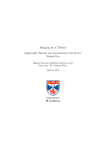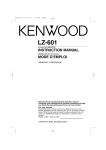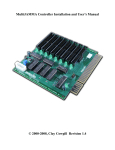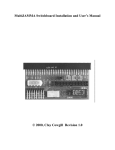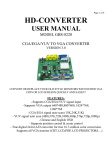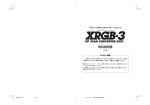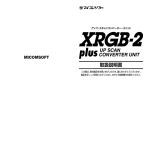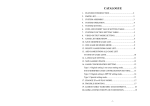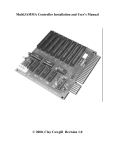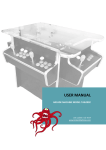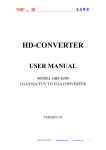Download This is a support manual for the GBS-8220 – which
Transcript
This is a support manual for the GBS-8220 – which comes in a one vga port and two port version. When using this board you want to read all the information in this document – there are many common mistakes/issues when using this for arcade conversion that can easily be cleared up. Most common is using a 1Amp power supply or wrong power. This board works best with 5V and at least 2Amps. Less than 2 Amps will give problems! Another common issue is Red Color increasing and video issues. Adjusting the "clamp ST" and "clamp SP" settings of the board will usually correct this. Other issues are incorrect signal connections. Who makes these cards? These are made by Gonbes. The model numbers are GBS-8200 / GBS-8220. They mostly look the same except the 8220 has 2 VGA D-SUB 15 connectors in output. http://en.gonbes.com/product_detail.asp?menuid=94&id=22 What is it? It's a pcb card for video upscaling, that can convert a 15Khz RGBS input (e.g. from a JAMMA board) or a composite (YPbPr) signal into a more conventional 31 Khz VGA output, compatible with most modern monitors and LCD/LED TVs (which no longer recognize 15Khz). Commonly used to convert old consoles/computers to a VGA signal, upgranding old cabs into newer monitors, and superguns of course. How well does it work? Your mileage may vary. Many people seem to be happy with it but many others have a number if issues. Outputs 60Hz so may be worse if your input is 50Hz. (I've only tried 60 Hz) What are the issues? The upscaling applies a bit of smoothing, which you can reduce using a "sharpness" setting. When in operation you may see some noise with some pixels flickering. This is barely noticeable (it's pixels of the output resolution so they're small) and some TVs may correct it (haven't tried). You may have sync issues if your grounding or power source is not good enough. Does it slow down the video? Probably but not as far as I can tell. The movement feels like 60Hz. I can notice some interlacing in some shadows (ie. for strong black flickering on white) but it's massively better than the FPS being put out by a Multi PCB for example (30 fps). (update: using a scanline filter improves the interlacing by hiding some of it. still noticeable but plenty playable) What's your take on it? My own experience is ok. There's minor noise in places (flickering dots or some colors bleeding into another - not big issue but you can tell it's not a PC). The noise is are more or less noticeable at different resolutions. I initially had sync issues - it would work fine for about an hour then the image would start to jump. That was due to a power supply that was not strong enough when it heated up. What's the difference between the GBS-8200 and the GBS-8220? As far as I can tell the only difference between the two seem to be an extra VGA output, probably a clone of the display. I only tried the 8200, so if anybody has more info, please share. Do I need a sync cleaner? Not for Superguns / JAMMA inputs. It would be needed if you connect a console or computer from it though. How to tell if it's genuine? Don't know. Apparently there are bootlegs of the card floating around that don't work as well. Mine looks identical to the one on Gonbes website, with the chinese title with a "III" on it. Is it better than a XRGB? Don't have an XRGB but I'm tempted to say the GBS is worse because: has noise of some pixels flickering, is very sensitive to input voltage, and the two voltage inputs seems to work differently (had issues with the "DC in" one, less with the other "molex" input). Other than that an XRGB upscaler costs 10 times more than the GBS, so I would hope it works better If I get a scanline filter do I need a different power supply? No - I saw on a video somebody using DC in on the GBS for the power supply, then chaining the scanline filter through the molex connector. The GBS actually has two power connectors, and it turns out that you can use one to connect another device. The SLG-3000 is 5V as well, so the setup works very well. What PSU do I need? 5V 2A at least. Any less (lower voltage or not enough amperage) will give you a red or blue screen with blocks (even without an input signal). Apparently the GBS8200 can accept 12V, but reportedly this seems to heat it which leads to different issues after running for some time. Gonbes website states 5V +/- 0.5, so stick to 5V. Personally, I use the same power supply as my JAMMA harness. Otherwise, I get sync issues (which could be due to grounding perhaps, I have not tried another setup). If you have a "bouncing" image (bad sync), it could be due to the power supply not being strong enough. CGA to VGA Video Converter GBS-8220 PCB Basic Setup Article Number: 13 | Rating: 3.9/5 from 7 votes | Last Updated: Thu, Feb 11, 2010 at 7:09 PM Included with the CGA/EGA/YUV to VGA HD-Converter PCB (GBS-8220) will be: • • • • The main GBS-8220 PCB 2-Pin +5VDC Power Cable 8-Pin (6 wire) RGB Cable GBS-8220 Manual (4 pages) STEP 1: Connect the VGA output monitor to P3 (VGA OUT) of the GBS-8220 Converter PCB. If connecting a second VGA monitor, connect the second monitor to P4 of the GBS-8220 converter PCB. STEP 2: Connect the incoming CGA, EGA, VGA, or component video source to the GBS-8220 converter PCB. Most new JAMMA harnesses include the special 5-pin white RGB connector. Below is a picture of this common RGB video connector found on newer JAMMA harnesses. If you have this type RGB connector then simply plug this connector directly into P3 of the GBS-8220 converter PCB. <-- 5-Pin RGB Video Connector Sample If you do not have the simple RGB connector shown above, the GBS-8220 converter PCB includes a RGB cable which can be used to adapter your CGA or EGA video source to the GBS8220 input. Since the output of the game or device you want to converter can vary you will need to figure out what the RGB output pinout is. Once the video wires from the game/device you intend to converter are known, connect/splice to the included 8-pin (6 wires) RGB cable. • • • • • • Red Video to Red Wire/P11 (R) Green Video to Green Wire/P11 (G) Blue Video to Blue Wire/P11 (B) H. Sync to Gray Wire/P11 (S) V. Sync to Yellow Wire/P11 (VS) Ground Ref to Black Wire/P11 (GND) Connect the 8-pin (6 wires) RGB cable to P11 on the GBS-8220 converter PCB. STEP 3: Connect the GBS-8220 PCB to your +5VDC Power Source by connecting the RED wire of the power cable to the +5VDC source and the BLACK wire to the DC GROUND source. Then connect the 2-pin connector of the power cable to the P9 on the GBS-8220 converter PCB. The power requirement for the GBS-8220 is +5VDC +/- .5VDC @ 2A. If the power supply cannot put out 2AMP then it may cause problems with the on-board converter CPU. Usually this converter PCB would be connected directly to an arcade game power supply which puts out +5VDC up to 15A current. When powering up the GBS-8220 converter PCB, after about 5 seconds try pressing the 'AUTO' button on the converter PCB. This should self-adjust and lock-in the picture on your VGA output monitor. If no good then remove the P11 wire harness from the converter P11 connector. Then move the GRAY WIRE over one position on the connector (so it is next to the YELLOW Wire). Then connect back into the converter and power up then try the AUTO button again. Item Review: Arcade RGBS CGA/EGA/YUV TO 2 VGA CONVERTER GBS-8220(NEW) Play your arcade boards on a standard computer vga monitor Item Link: http://www.arcademvs.com/rgbstovga.htm Main Site Link: http://www.arcademvs.com/ Their Ebay Store Link:http://stores.ebay.com/Y-PLUS Description: The high definition converter GBS-8220 it’s professional of game convert. Support all games(Amusement、Playstation、Xbox、wii……)convert to CRT monitor 、LCD monitor 、PDP monitor…… Auto scan CGA/EGA/YUV signal, Two VGA outputs , output high resolution signal. *Supports CGA/EGA/YUV signal input *Supports VGA output 640*480,800*600,1024*768,1360*768 *CGA/EGA signal auto scan(15K,24K,31K) *YUV signal auto scan(480i,576i,720i,1080i,480p,576p,720p,1080p) *Chinese and English OSD *Supports position control & zoom control *True digital 24-bit A/D converter for true 16.7-million color conversion *Supports all VGA monitor (CRT、LCD、PDP、PROJECT……) (Item Description taken directly from their ebay ad. Broken english and all) My Score: 4 out of 5 Value: 5 Item was actually purchased from their ebay store for $39.00 and $12.00 shipping for a total of $51.00 USD. For the features it promissed this is a pretty good deal. Packaging: 3 I know that it's not the reason you purchase one of these but it does say a little about how a company works. As you can see in the images below the packaging isn't very durable. They did at least make an attempt to mark it Fragile. It also took about 3 weeks to reach me after purchase in the central USA area. Contents: 4 You get all the cables you need and a nice little board with holes for mounting feet. (nice forward thinking) NO feet included. I added those you see in the pics. The cables have the connectors needed for each of it's available connection types. Now the negatives. The manual is ugly. 4 poorly printed pages. Some are blurry and hard to read. Not a huge deal but you should at least make the prints clean and clear. Installation: 5 What a simple breeze this turned out to be. Depending on your game pcb board type, use one of the 3 available inputs and let the auto detect do the rest. Once I hooked it up and turned it on all I had to do next was configure it. Configuration: 4 I would of given it a 5 if the menu was defaulted in English. Instead it comes up in Chinese and I had to fumble through to the last menu to find the language select. At least there is an english option. Without that I was just fumbling around. However, once in English the menu was very simple. Lots of sensible options that got me everything I needed and easy to navigate. I was able to get my brightness, holds etc exactly where I needed it. As well as the resolution size which is kinda odd. 1360 x 768? I'm sure there is a reason.. There are 3 pots as well that control the color settings. Nice.. Usage: 5 The first time I powered off the machine I was worried. When I powered it back on it didn't appear as if it saved my resolution settings. I was concerned that all my other settings were not saved either. After checking it did save my configuration settings but not my resolution setting. I set the resolution setting again and powered it off again. This time when it came on it did infact save all my settings including resolution. I tested the power off and on many times to be sure. Every time it came up it was all there and saved. Conclusion: My Score 4 out of 5 I'm very satisfied with the results this board has provided. I found very little information on this item when I did my initial searches. Therefore I'm hoping my review will help anyone out who may be in the market for a converter such as this one. Thank you and happy gaming DSCN1413.jpg (123.59 kB, 1024x768 - viewed 171 times.) DSCN1425.JPG (175.21 kB, 1024x768 - viewed 426 times.) DSCN1416.JPG (134.47 kB, 1024x768 - viewed 295 times.) DSC02238.jpg (247.71 kB, 1024x768 - viewed 713 times.) DSC02251.jpg (200.75 kB, 1024x768 - viewed 145 times.) DSC02252.jpg (225.88 kB, 1024x768 - viewed 110 times.) DSC02253.jpg (163.64 kB, 1024x768 - viewed 126 times.) DSC02254.jpg (204.17 kB, 1024x768 - viewed 96 times.) « Last Edit: May 14, 2009, 12:01:34 pm by supadave » Logged supadave • • • • • • Full Member Offline Posts: 131 Re: Review: Arcade RGBS CGA/EGA/YUV TO 2 VGA CONVERTER « Reply #1 on: May 14, 2009, 11:52:34 am » More Images.. (Game is blurry in photos due to motion and crappy camera) DSC02255.jpg (144.04 kB, 1024x768 - viewed 89 times.) DSC02246.jpg (179.79 kB, 1024x768 - viewed 371 times.) DSC02249.jpg (251.75 kB, 1024x768 - viewed 303 times.) DSCN1417.JPG (258.56 kB, 1024x768 - viewed 224 times.) DSCN1418.JPG (243.27 kB, 1024x768 - viewed 164 times.) DSCN1419.JPG (229.62 kB, 1024x768 - viewed 179 times.) DSCN1420.JPG (208.37 kB, 1024x768 - viewed 197 times.) DSC02243.jpg (181.9 kB, 1024x768 - viewed 432 times.) What I've tested so far: MVS: Very very good. Brightness is perfect with the best picture visible with the pots at about %95. Only the shimmer is problematic, and its really not that bad at all, honestly. Saturn: Tapped RGB from the board, no modifications needed. Image is fucking amazing (except for the shimmer). PC Engine: couldn't sync, image seen only briefly. Will build amp and test again. Genesis 1: Image couldn't sync, and when briefly seen it was very dark. Will modify RGB signal with the resistors/caps seen in UK SCART cable schematics and try again. Game Cube: Using OEM component cable things look really good. 3D games make the shimmer really hard to notice. PS2: Using OEM component cable, same results as GC.













